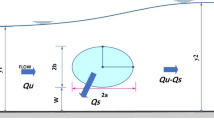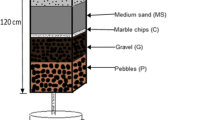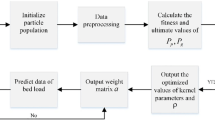Abstract
Accurately prediction of discharge coefficient through radial gates is considered as a challenging hydraulic subject, particularly under highly submerged flow conditions. Incurring the advantages of kernel-depend extreme learning machine (KELM), this study offers a grey wolf optimization-based KELM (GWO-KELM) for effective prediction of discharge coefficient through submerged radial gates. Additionally, support vector machine (SVM) and Gaussian process regression (GPR) methods are also presented for comparative purposes. To build prediction models using GWO-KELM, GPR, and SVM, an extensive experimental database was established, consisting of 2125 data samples gathered by the US Bureau of Reclamation. From simulation results, it is observed that the proposed GWO-KELM approach with radial basis function and input parameters of the ratio of the downstream flow depth to the gate opening and submergence ratio provides the best performance with the correlation coefficient (R) of 0.983, the determination coefficient (DC) of 0.966 and the root-mean-squared error (RMSE) of 0.027. The obtained results showed that the proposed GWO-KELM with RBF kernel function gives better prediction accuracy than employed GPR and SVM approaches. Furthermore, the obtained results showed that the employed kernel-depend methods are capable of a statistically predicting the discharge coefficient under varied submergence conditions with satisfactory level of accuracy. Amon theme, proposed hybrid GWO-KELM method gave the most accurate results (R = 0.873, DC = 0.744, and RMSE = 0.035) for extremely highly submerged flow. Moreover, the results reflected that the employed kernel-depend methods give better predictions than the developed dimensionless formulas.











Similar content being viewed by others
Availability of data and materials
The data and materials that support the findings of this study are available on request from the corresponding author.
Abbreviations
- Q :
-
Flow discharge (m3/sec)
- C d :
-
Discharge coefficient
- y 1 :
-
Upstream flow depth
- y 2 :
-
Flow depth at vena contracta (m)
- y 3 :
-
Downstream flow depth (m)
- L :
-
Channel width (m)
- w :
-
Gate opening (m)
- α :
-
Gate trunnion height above the invert (m)
- θ :
-
Gate leaf angle from horizontal (°)
- Re:
-
Reynolds number
- y 1−y 3/w :
-
Submergence ratio
- y 1/R :
-
Upstream flow depth to the hydraulic radius ratio
- y 3/R :
-
Downstream flow depth to the hydraulic radius ratio
- y 3/w :
-
Downstream flow depth to the gate opening ratio
- μ :
-
Water viscosity
- ρ :
-
Water density
- g:
-
Gravitational constant (m/s2)
References
Abdelhaleem FSF (2016) Discharge estimation for submerged parallel radial gates. Flow Meas Instrum 52:240–245
Al-qaness MA, Ewees AA, Abd Elaziz M (2021) Modified whale optimization algorithm for solving unrelated parallel machine scheduling problems. Soft Comput 25(14):9545–9557
Al-qaness, M. A., Ewees, A. A., Fan, H., AlRassas, A. M., & Abd Elaziz, M. (2022). Modified aquila optimizer for forecasting oil production. Geo-spatial Information Science, 1–17.
Ansar M, Ferro V (2001) Simultaneous Flow over and under a Gate. J Irrig Drain Eng 127(5):325–328
Azamathulla HM, Haghiabi AH, Parsaie A (2016) Prediction of side weir discharge coefficient by support vector machine technique. Water Sci Technol Water Supply 16(4):1002–1016
Bilhan O, Emiroglu ME, Kisi O (2011) Use of artificial neural networks for prediction of discharge coefficient of triangular labyrinth side weir in curved channels. Adv Eng Softw 42(4):208–214
Buyalski CP (1983) Discharge algorithms for canal radial gates (No. 627.13 B8)
Chen W, Sharifrazi D, Liang G, Band SS, Chau KW, Mosavi A (2022) Accurate discharge coefficient prediction of streamlined weirs by coupling linear regression and deep convolutional gated recurrent unit. Eng Appl Comput Fluid Mech 16(1):965–976
Clemmens AJ, Strelkoff TS, Replogle JA (2003) Calibration of submerged radial gates. J Hydraul Eng 129(9):680–687
Dahou A, Al-qaness MA, Abd Elaziz M, Helmi A (2022) Human activity recognition in IoHT applications using arithmetic optimization algorithm and deep learning. Measurement 199:111445
Ferro V (2001) Closure to ‘Simultaneous flow over and under a gate’by V. Ferro. J Irrig Drainage Eng 127(5):326–328
Garg H (2015) A hybrid GA-GSA algorithm for optimizing the performance of an industrial system by utilizing uncertain data. In Handbook of research on artificial intelligence techniques and algorithms (pp. 620–654). IGI Global.
Garg H (2016) A hybrid PSO-GA algorithm for constrained optimization problems. Appl Math Comput 274:292–305
Guo X, Guo Y, Wang T, Fu H, Li J (2021) Study and application of discharge calibration for submerged radial gates. Flow Meas Instrum 78:101912
Guo YX, Guo XL, Wang YS, Wang T, Fu H, Li JZ (2020) Flow condition identification and discharge calibration for submerged radial gates. J Hydraulic Res, pp 1–8
Haghiabi AH, Parsaie A, Ememgholizadeh S (2018) Prediction of discharge coefficient of triangular labyrinth weirs using adaptive neuro fuzzy inference system. Alex Eng J 57(3):1773–1782
Huang GB, Zhu QY, Siew CK (2006) Extreme learning machine: theory and applications. Neurocomputing 70(1–3):489–501
Huang GB, Zhou H, Ding X, Zhang R (2011) Extreme learning machine for regression and multiclass classification. IEEE Trans Syst Man Cyber Part B (Cybernetics) 42(2):513–529
Karami H, Karimi S, Bonakdari H, Shamshirband S (2018) Predicting discharge coefficient of triangular labyrinth weir using extreme learning machine, artificial neural network and genetic programming. Neural Comput Appl 29(11):983–989
Karbasi M, Jamei M, Ahmadianfar I, Asadi A (2021) Toward the accurate estimation of elliptical side orifice discharge coefficient applying two rigorous kernel-based data-intelligence paradigms. Sci Rep 11(1):1–18
Kundu T, Garg H (2021) A hybrid ITLHHO algorithm for numerical and engineering optimization problems. Int J Intell Syst
Le D, Chen Z, Wong YW, Isa D (2020) A complete online-SVM pipeline for case-based reasoning system: a study on pipe defect detection system. Soft Comput 24(22):16917–16933
Liao K, Wu Y, Miao F, Li L, Xue Y (2020) Using a kernel extreme learning machine with Grey Wolf Optimization to predict the displacement of step-like landslide. Bull Eng Geol Env 79(2):673–685
Luo J, Chen H, Hu Z, Huang H, Wang P, Wang X, Wen C (2019) A new kernel extreme learning machine framework for somatization disorder diagnosis. IEEE Access 7:45512–45525
Metzler DE (1948) A model study of Tainter-gate operation. Doctoral dissertation, State University of Iowa
Mirjalili S, Mirjalili SM, Lewis A (2014) Grey wolf optimizer. Adv Eng Softw 69:46–61
Moslehi F, Haeri A, Martinez-Alvarez F (2020) A novel hybrid GA–PSO framework for mining quantitative association rules. Soft Comput 24(6):4645–4666
Parsaie A, Haghiabi A (2015) The effect of predicting discharge coefficient by neural network on increasing the numerical modeling accuracy of flow over side weir. Water Resour Manage 29(4):973–985
Rasmussen CE, Nickisch H (2010) Gaussian processes for machine learning (GPML) toolbox. J Mach Learn Res 11:3011–3015
Roushangar K, Shahnazi S (2019) Bed load prediction in gravel-bed rivers using wavelet kernel extreme learning machine and meta-heuristic methods. Int J Environ Sci Technol 16(12):8197–8208
Roushangar K, Shahnazi S (2020a) Determination of influential parameters for prediction of total sediment loads in mountain rivers using kernel-based approaches. J Mt Sci 17(2):480–491
Roushangar K, Shahnazi S (2020b) Prediction of sediment transport rates in gravel-bed rivers using Gaussian process regression. J Hydroinf 22(2):249–262
Roushangar K, Shahnazi S (2021) Insights into the prediction capability of roughness coefficient in current ripple bedforms under varied hydraulic conditions. J Hydroinf 23(6):1182–1196
Roushangar K, Asl MM, Shahnazi S (2021a) Hydraulic performance of PK weirs based on experimental study and kernel-based modeling. Water Resources Manage, pp 1–22
Roushangar K, Nouri A, Shahnazi S, Azamathulla HM (2021b) Towards design of compound channels with minimum overall cost through Grey Wolf Optimization algorithm. J Hydroinf 23(5):985–999
Roushangar K, Shahnazi S, Azamathulla HM (2022) Partitioning strategy for investigating the prediction capability of bed load transport under varied hydraulic conditions: application of robust GWO-kernel-based ELM approach. Flow Meas Instrum 84:102136
Salmasi F, Yıldırım G, Masoodi A, Parsamehr P (2013) Predicting discharge coefficient of compound broad-crested weir by using genetic programming (GP) and artificial neural network (ANN) techniques. Arab J Geosci 6(7):2709–2717
Shahrokhnia MA, Javan M (2006) Dimensionless stage–discharge relationship in radial gates. J Irrig Drain Eng 132(2):180–184
Shahrokhniya MA, Javan M (2005) Obtained of discharge coefficient in radial gates. Hydraulic Magazine 1:1–11
Shamshirband S, Bonakdari H, Zaji AH, Petkovic D, Motamedi S (2016) Improved side weir discharge coefficient modeling by adaptive neuro-fuzzy methodology. KSCE J Civ Eng 20(7):2999–3005
Tabari MMR, Hashempour M (2019) Development of GWO–DSO and PSO–DSO hybrid models to redesign the optimal dimensions of labyrinth spillway. Soft Comput 23(15):6391–6406
Toch A (1955) Discharge characteristics of Tainter gates. Trans Am Soc Civ Eng 120(1):290–300
Vn V (1995) The nature of statistical learning theory. Springer-Verlag, New York
Wahl TL (2005) Refined energy correction for calibration of submerged radial gates. J Hydraul Eng 131(6):457–466
Wang F, Zhang Y, Rao Q, Li K, Zhang H (2017a) Exploring mutual information-based sentimental analysis with kernel-based extreme learning machine for stock prediction. Soft Comput 21(12):3193–3205
Wang M, Chen H, Li H, Cai Z, Zhao X, Tong C, Xu X (2017b) Grey Wolf Optimization evolving kernel extreme learning machine: application to bankruptcy prediction. Eng Appl Artif Intell 63:54–68
Yousri D, AbdelAty AM, Al-qaness MA, Ewees AA, Radwan AG, Abd Elaziz M (2022) Discrete fractional-order Caputo method to overcome trapping in local optima: Manta Ray Foraging Optimizer as a case study. Expert Syst Appl 192:116355
Zahedani MR, Keshavarzi A, Javan M, Shahrokhnia MA (2012) New equation for estimation of radial gate discharge. In Proceedings of the institution of civil engineers-water management (vol 165, No 5, pp 253–263). Thomas Telford Ltd.
Zhou F, Han J, Yang X (2021) Multivariate hierarchical multiscale fluctuation dispersion entropy: applications to fault diagnosis of rotating machinery. Appl Acoust 182:108271
Funding
No funding was received for conducting this study.
Author information
Authors and Affiliations
Corresponding author
Ethics declarations
Conflict of interest
The authors declare that they have no competing interests.
Ethical approval
Not applicable, because this article does not contain any studies with human or animal subjects.
Consent to participate
Not applicable.
Consent for publication
Not applicable.
Additional information
Publisher's Note
Springer Nature remains neutral with regard to jurisdictional claims in published maps and institutional affiliations.
Rights and permissions
Springer Nature or its licensor (e.g. a society or other partner) holds exclusive rights to this article under a publishing agreement with the author(s) or other rightsholder(s); author self-archiving of the accepted manuscript version of this article is solely governed by the terms of such publishing agreement and applicable law.
About this article
Cite this article
Roushangar, K., Shahnazi, S. & Sadaghiani, A.A. An efficient hybrid grey wolf optimization-based KELM approach for prediction of the discharge coefficient of submerged radial gates. Soft Comput 27, 3623–3640 (2023). https://doi.org/10.1007/s00500-022-07614-7
Accepted:
Published:
Issue Date:
DOI: https://doi.org/10.1007/s00500-022-07614-7




